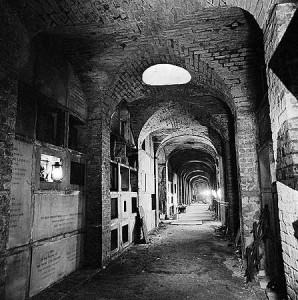We took the opportunity when we were in London last week of visiting Highgate Cemetery, the famous Victorian cemetery in Hampstead in London’s North.
On our way, we were rather aggrieved to find out that this poor street has no parents.

We walked on through Hampstead Heath, pausing on Parliament Hill to take in the distant cloudy vista of London below us.

Meanwhile, behind us, a young woman who’d sprinted up the hill coughed and hacked and generally went about dying after her run. Some people asked her if she was okay, but her headphones were up so loud she didn’t hear. I hope she was okay.
We were in one of those annoying time warps where we didn’t have quite enough time to go check out Kenwood House, but had too much time to just meander, particularly on a chilly London day. We wandered through a small collection of shops, possibly Highgate West Hill, which google tells me is one of the more expensive parts of London. Perhaps that explains this rather tight entry in the local real estate market.

East Cemetery
Arriving an hour early for our tour of the West Cemetery, we spent some time poking about in the East Cemetery, seeing if anyone interesting had found their resting place there.

The first grave we found was that of Douglas Adams. Coming right off the back of the news of the death of Terry Pratchett, this was a bit of an emotional find. I loved the headstone, which said simply ‘writer’. Fans have taken to leaving pens and pencils in the vase, and a cat visited briefly before scampering off.
We also visited George Eliot, Karl Marx and whoever this producer dude was with a great headstone.
West Cemetery
There are far fewer ‘famous’ or ‘interesting’ people to be found over in the West Cemetery, but it’s a beautiful space, quite wild; overtaken by brambles and trees that pull down headstones and force graves to fall in on themselves. Our guide warned us to stay on the path – or risk falling into a collapsed grave. It was a wonderful tour, and it’s well worth reading up on the history of the place. Started in 1839 as both a solution to overcrowding in London’s cemeteries and a business venture, it was popular for many years until falling into decline and eventual ruin in the 20th century. It was rescued by the Friends of Highgate Cemetery Trust in the 1970s who run and maintain it today.

A quick search for Highgate Cemetery will reveal lovely pictures of the Circle of Lebanon and the Egyptian Avenue, much nicer than anything I could take. And if it’s spectacular shots of dramatic graves you’re after, I’m not sure if this is the right place for you. It’s kind of… low key, in spite of all its grandeur. The grandeur is of course faded, but on top of that is the fact that you’re very often quite close to dead bodies. Many of the graves are earthless – there’s nothing between the tombstone and the coffin, except dust and leaves that have blown in over time.
Towards the end of the tour, the wonderful guide took us into the Terrace Catacombs, a cold dark place where you could almost reach out and touch the coffins, with the fronts of their tombs broken away, except that you might get lead poisoning. Photography is not permitted in this part, and I’d say it’s because you are so very close to the dead.

Surprisingly, the cemetery is still used, and one of the more famous recent burials was that of Alexander Litvinenko, the former Russian secret service officer who was poisoned in London in 2006.
After the tour, our guide escorted us back to the land of the living where, who knows? We probably had a beer.
—
Guided tours run every week day at 1:45pm and tickets must be bought in advance. Weekend tours are every half hour and there’s no need to book.
Visit the official Highgate Cemetery website for more information.









